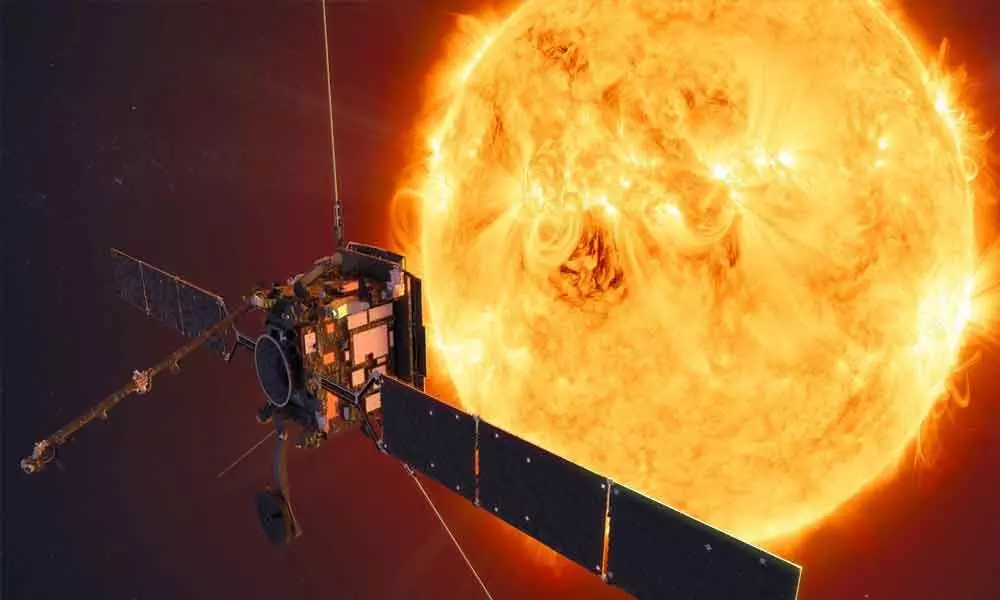Live
- 3 held, 810 kg ganja seized
- Workshop on ‘Live Agri-technologies’ concludes at SPMVV
- Advancing Biomedical Research with NMR techniques
- Key Highlights of India in 2024
- Expose Opposition’s evil propaganda in villages: Seethakka to Cong workers
- MLA Sudhir focuses on amenities at Srikalahasti rly station
- Chittoor police crack down on drunk driving with 963 cases
- Vision document historical, says Keshav
- YSRCP to boycott elections to WUAs
- Farmers led by YSRCP leaders stage protest against graft
Just In
NASA Solar Orbiter Lift Off: Solar Science Reaches New Heights


The Solar Orbiter mission primary objective is to notice the Sun with high spatial resolution telescopes.
Solar Orbiter, an international collaborative mission between NASA and ESA (European Space Agency), successfully lifted off onboard a United Launch Alliance Atlas V 411 rocket from Space Launch Complex 41 at Cape Canaveral Air Force Station (CCAFS) in Florida.
The Solar Orbiter mission's main objective is to observe the Sun with high spatial resolution telescopes that are fixed on the Orbiter. The mission will also capture observations in the environment directly surrounding the spacecraft to create a unique picture of how the Sun can affect the space environment throughout our solar system.
After the lift-off, the Atlas V's single solid rocket booster was jettisoned, and the vehicle performance was as expected.
In the next phase, the first of two burns for the Centaur upper stage was ongoing following burnout and separation of the Atlas booster.
"This is an approximately eight-minute burn. The payload fairing, having protected the spacecraft in the early minutes of flight, has separated and fallen away as planned," NASA updated to the Solar Orbiter spacecraft mission.
Teams are reporting good performance so far of the #SolarOrbiter launch. Watch as @ULAlaunch's #AtlasV continues to propel the spacecraft on its journey to the Sun: https://t.co/W3wMEfPxvB pic.twitter.com/xq4eO4U3vL
— NASA (@NASA) February 10, 2020
"The spacecraft also will provide the first-ever images of the Sun's poles and the never-before-observed magnetic environment there, which helps drive the Sun's 11-year solar cycle and its periodic outpouring of solar storms," NASA detailed in its mission objective for Solar Orbiter.
Mach 1!
— ESA Operations (@esaoperations) February 10, 2020
Solar Orbiter, inside the Atlas V rocket, is now travelling faster than the speed of sound#SuperSonicOrbiter🔊#WeAreAllSolarOrbiters☀️ pic.twitter.com/sPTmTVoetD
"Successful staging, ignition of the Centaur upper stage and payload fairing jettison is confirmed! The vehicle now weighs just 7 per cent of its lift-off mass," ULA in a tweet update wrote. In another tweet, NASA said that the Solar Orbiter, inside the Atlas V rocket, was roving faster than the sound speed.
3-2-1 LIFTOFF! 🚀 We have liftoff of #SolarOrbiter at 11:03pm ET atop @ULAlaunch's #AtlasV rocket as the spacecraft begins its journey to snap the first pictures of the Sun's north and south poles. Watch: https://t.co/W3wMEfPxvB pic.twitter.com/0F6Jk6vhML
— NASA (@NASA) February 10, 2020
As per the reports, the Solar Orbiter, a $672 million mission, will act as a mobile space laboratory that will observe the Sun and how it will affect the space environment throughout our solar system.

© 2024 Hyderabad Media House Limited/The Hans India. All rights reserved. Powered by hocalwire.com






